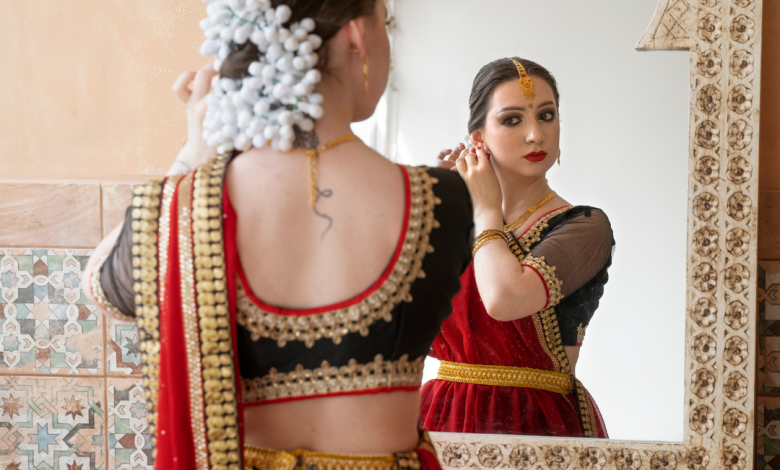Different Ways to Drape a Saree

In this article we are going to discuss Different Ways to Drape a Saree. The saree, a quintessential symbol of grace and cultural heritage, has been an integral part of Indian attire for centuries. This timeless garment, consisting of a long piece of cloth ranging from five to nine yards, is versatile enough to be draped in numerous styles, each reflecting regional traditions, personal preferences, and the occasion. The art of draping a saree is not just about fashion; it embodies the cultural diversity and rich traditions of India.
Different Ways to Drape a Saree
Here, we delve into the myriad ways of wrapping a saree, each narrating its unique story.
1. Nivi Style
The Nivi style, which originated in Andhra Pradesh, is one of the most prevalent and widely adopted saree draping techniques.It has gained immense popularity across India due to its simplicity and elegance. To drape a saree in the Nivi style, one must start by tucking the saree into the petticoat, ensuring it falls evenly to the floor. The saree is then wrapped around the waist, brought over the left shoulder, and the pleats are neatly arranged in front. What makes this style distinctive are the pleats and the pallu (the loose end of the saree).The pallu can either be left hanging or pinned for convenience, offering a blend of tradition and practicality.
2. Bengali Style
The Bengali style of draping a saree exudes opulence and charm, often reflecting the cultural richness of Bengal.This style is characterized by its unique way of pleating and pallu draping. Unlike the Nivi style, the Bengali saree does not require pleats at the front. Instead, the saree is wrapped around the waist and the pallu is brought from the back over the right shoulder, draped loosely and gracefully. A key feature is the use of a bunch of keys or a traditional ornament to secure the pallu on the shoulder, adding a touch of elegance.
Also Check: 10 Best Websites to buy Sarees in India
3. Gujarati Style
The Gujarati style, also known as the Seedha Pallu, is a vibrant and colorful way of draping a saree, reflecting the lively culture of Gujarat. In this style, once the saree is tucked and pleated, the pallu is draped over the right shoulder instead of the left, as seen in the Nivi style.The pallu is spread out across the chest and secured at the back, showcasing the intricate designs and embroidery of the saree. This style is particularly popular during traditional events and festivals in Gujarat.
4. Maharashtrian Style
The Maharashtrian style, or the Nauvari saree, is distinctive for its dhoti-like drape, symbolizing the valor and tradition of Maharashtra. This style requires a longer saree, typically nine yards. The saree is draped without a petticoat, and is wrapped around the legs in a manner similar to a dhoti. The remaining portion is pleated and draped over the shoulder. This style, often worn by women in rural Maharashtra, offers freedom of movement and a touch of traditional elegance, making it ideal for festive occasions and dance performances like Lavani.
5. Tamilian Style
The Tamilian style of draping a saree, also known as the Madisar, is primarily worn by the Iyer and Iyengar communities of Tamil Nadu during religious ceremonies and weddings. This style uses a nine-yard saree, similar to the Maharashtrian style, but with a different draping method. The saree is wrapped around the waist, with one end tucked in the back. The pleats are arranged in the front and secured. The pallu is then draped over the shoulder, brought under the opposite arm, and tucked in at the back. This complex style symbolizes grace and cultural heritage, often worn by married women during significant rituals.
6. Kerala Style
The Kerala style, or the Mundum Neriyathum, is a simple yet elegant way of draping a saree, prevalent in the state of Kerala. This traditional attire consists of two pieces: the mundu (lower garment) and the neriyathu (upper garment). The mundu is wrapped around the waist like a skirt, while the neriyathu is draped over the shoulder like a dupatta. This style is typically worn in white or off-white with golden borders, signifying purity and simplicity. It is commonly seen during festivals like Onam and Vishu, adding to the cultural vibrancy of Kerala.
7. Karnataka Style
The Karnataka style, often referred to as the Kodagu style, is a distinctive way of draping a saree that hails from the Coorg region. This style features a unique pleating method and pallu draping. The saree is first wrapped around the waist with pleats at the back. The pallu is then draped over the right shoulder and secured with a pin. The loose end is brought under the left arm and tucked into the waist. This style is particularly popular among the Kodava community and is often seen during traditional ceremonies and weddings in Karnataka.
Also Check: Top Websites in the World
8. Mumtaz Style
The Mumtaz style, named after the iconic Bollywood actress Mumtaz, is a glamorous and retro way of draping a saree. Popularized during the 1960s and 1970s, this style is characterized by its sleek and snug fit, accentuating the curves. The saree is draped to hug the body, with multiple layers wrapped tightly around the lower part, and the pallu elegantly draped over the shoulder.This style, often seen in vintage Bollywood movies, adds a touch of sophistication and old-world charm, making it perfect for parties and special occasions.
9. Lehenga Style
The Lehenga style is a fusion of the traditional saree and the lehenga choli, offering a modern twist to the classic drape. This style is particularly popular among brides and young women who want a contemporary yet traditional look. The saree is draped in a manner that it resembles a lehenga, with the pleats arranged around the waist to create a flared skirt effect.The pallu is then draped over the shoulder, often adorned with elaborate embellishments and embroidery. This style is ideal for weddings, receptions, and festive occasions, exuding elegance and grace.
10. Belt Style
The Belt style is a trendy and contemporary way of draping a saree, incorporating a belt to cinch the waist. This style adds a touch of modernity and sophistication to the traditional saree. The saree is draped in the Nivi style or any preferred style, and a belt is fastened around the waist to secure the pleats and pallu. This not only accentuates the waist but also provides ease of movement, making it a popular choice for fashion-forward individuals. The belt can be a traditional kamarband or a modern statement piece, adding a unique flair to the attire.
11. Pant Style
The Pant style is a contemporary and chic way of draping a saree, blending the traditional saree with the comfort of pants. This style is perfect for those who want to make a fashion statement while ensuring ease of movement. The saree is draped over a pair of leggings or pants, with the pleats arranged at the front and the pallu draped over the shoulder. This style offers a modern twist to the classic saree, making it ideal for office wear, casual outings, and parties.It allows for experimentation with various types of pants and accessories, resulting in a versatile and stylish look.
12. Butterfly Style
The Butterfly style is a glamorous and fashionable way of draping a saree, perfect for special occasions and parties. This style is characterized by its uniquely pleated pallu, resembling butterfly wings. The saree is draped in the Nivi style, but the pallu is pleated in very thin and fine pleats, spread out over the shoulder to create a dramatic effect. This style accentuates the blouse and adds a touch of sophistication and elegance. It is a favorite among fashion enthusiasts and celebrities, often seen on red carpets and high-profile events.
13. Rajrani Style
The Rajrani style is a royal and regal way of draping a saree, inspired by the traditional attire of Indian royalty. This style is characterized by its elaborate draping and use of luxurious fabrics and embellishments. The saree is draped in a manner that showcases the intricate designs and rich textures. The pallu is often draped over both shoulders or styled in a cascading manner, adding a touch of grandeur and elegance. This style is perfect for weddings, receptions, and formal events, exuding a sense of nobility and opulence.
14. Maharani Style
The Maharani style, also known as the Royal style, is another regal way of draping a saree, reminiscent of the attire worn by queens and princesses in ancient India. This style involves elaborate pleating and draping, often using rich fabrics like silk and brocade. The saree is draped in a manner that highlights the pallu, which is often draped over the head or styled in a flowing manner over the shoulder. This style exudes elegance and sophistication, making it ideal for weddings, cultural events, and formal occasions.
15. Dhoti Style
The Dhoti style is a unique and unconventional way of draping a saree, inspired by the traditional Indian dhoti. This style is characterized by its dhoti-like draping around the legs, offering a blend of tradition and modernity. The saree is draped without a petticoat, with the pleats arranged around the waist and the pallu draped over the shoulder. This style is comfortable and allows for easy movement, making it an ideal choice for various occasions. The Dhoti style is particularly popular among young women who appreciate the freedom and ease it provides, while still maintaining an elegant and traditional appearance. It’s a perfect choice for events that require both style and practicality, such as cultural performances, casual gatherings, and festive celebrations.
Conclusion
The versatility of the saree lies in its ability to be draped in countless styles, each reflecting the diverse cultural heritage of India. From the ubiquitous Nivi style to the regal Maharani drape, each method of wearing a saree tells a story of its own, rooted in regional traditions and personal expression. The Bengali and Gujarati styles celebrate the cultural richness of their respective regions, while the Maharashtrian and Tamilian styles reflect the valor and spiritual significance of their communities. Modern adaptations like the Lehenga, Belt, and Pant styles showcase the evolving fashion sensibilities, blending tradition with contemporary trends. The Dhoti style, with its unique draping method, exemplifies the fusion of comfort and elegance.
Each draping style not only highlights the saree’s aesthetic beauty but also underscores its functional versatility. Whether for daily wear, festive occasions, weddings, or formal events, there is a saree draping style to suit every need and preference. This adaptability has allowed the saree to remain a beloved garment across generations, transcending time and fashion trends.
The art of saree draping is a testament to India’s rich cultural tapestry, celebrating the diversity and unity of its people.As fashion continues to evolve, the saree stands as a symbol of timeless elegance, embodying the essence of Indian heritage while embracing modernity. Whether worn traditionally or with a contemporary twist, the saree remains a cherished and iconic attire, a true embodiment of grace and sophistication. So, I hope now you have understood Different ways to Drape a Saree.



